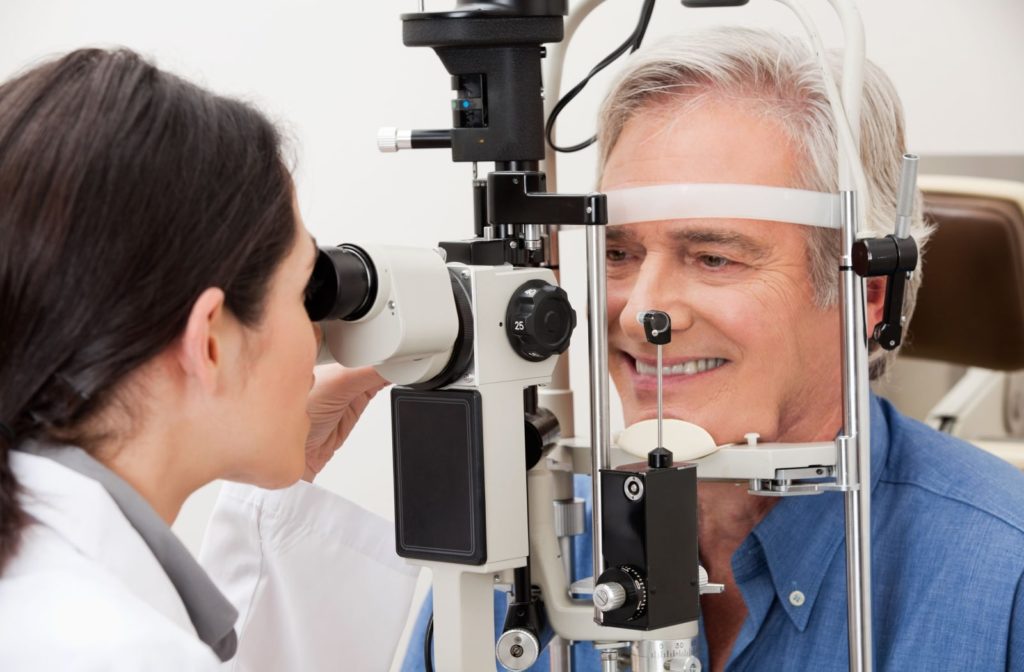Astigmatism is a common refractive error that occurs in about 1 in 3 people. Fortunately, astigmatism can be treated in a variety of ways, with glasses, contacts, or refractive surgery.
Like other refractive errors, astigmatism can worsen over time due to factors such as age, eye injuries, or ocular conditions like Keratoconus.
What Is Astigmatism?
Astigmatism is a refractive error like myopia or hyperopia. A normal eye is round like a basketball. With astigmatism, the shape of the eye changes and becomes oval-shaped like a football.
The shape of the eye affects vision. When an eye is round, internal structures like the cornea and the lens have an even round shape. When light enters the cornea, it bends to focus on the retina. This helps us see clearly.
Astigmatism can be caused by either the cornea or the lens of your eye having an irregular shape.
When the eye becomes oval-shaped, light rays don’t bend properly as they enter the cornea and cannot focus on the retina. This leads to blurry vision.
Vision is blurry both near and far because light rays fall short of the retina, or behind the retina.
Symptoms that suggest an individual may have an astigmatism include:
- Blurry or distorted vision at any distance
- Eye strain
- Headaches
- Squinting
- Difficulty night driving
Individuals with astigmatism may also have additional refractive errors like myopia (nearsightedness) or hyperopia (farsightedness).
How Is Astigmatism Diagnosed?
Astigmatism is diagnosed by an optometrist during an eye exam. Visiting your optometrist for a comprehensive eye exam is key to maintaining healthy vision and ocular health.
Your optometrist can diagnose astigmatism based on a series of tests.
During your exam, a machine called an autorefractor is used to provide an estimate of your vision prescription and keratometry values. Keratometry helps to determine the curvature of your cornea and is used to measure astigmatism.
A visual acuity assessment is used to measure how well an individual can focus on an object. This test includes a chart that shows a series of letters in rows that decrease in size. Your optometrist will ask you to read each row of letters to the best of your ability to determine how well you can read these letters.
During the refraction test, your eye doctor will place different lenses in front of your eye to measure how light bends through your cornea. With each lens option, your doctor will ask if the letters on the visual acuity chart become more or less clear.
The lens options during the refraction test will help your optometrist determine the vision prescription that allows you to see the clearest.
What Causes Astigmatism & How Can it Worsen?
Astigmatism can present at birth. If you have a family history of astigmatism or ocular diseases like keratoconus, you may develop astigmatism. Rubbing, or placing too much pressure on your eyes can also cause astigmatism.
Astigmatism, like other refractive errors, can worsen over time causing your vision prescription to change. Factors like age, eye injuries, or keratoconus can lead to worsened astigmatism. However, astigmatism can also decrease.
Aging
We attribute many physical changes to aging, and eyesight is no exception. As we age, the cornea may change in shape and become more oblong. This can worsen existing astigmatism and may occur because of changes in our eye muscles.
Eye Injuries
Eye injuries can occur in a variety of ways, the result of factors such as foreign objects in the eye, chemical burns, or blunt force trauma. A scratched cornea from a foreign body or chemical burn may heal irregularly, affecting its shape. If the lens of the eye becomes damaged, light may refract unevenly.
These injuries damage the cornea, the lens of our eye, or the retina, all of which are involved in the sequence of bending light to focus on the retina. If any of these eye structures become injured, it can worsen existing astigmatism.
If you experience an eye injury, visit your optometrist right away to assess the damage, prevent further injury, and help ensure the safety and health of your eyes.
Keratoconus
Keratoconus is a progressive condition where the cornea bulges outward into a cone shape and becomes thinner and weaker. Keratoconus impacts vision because the cone-shaped distortion worsens astigmatism.

How Is Astigmatism Treated?
There are several ways to correct astigmatism. The best treatment option is the one most suited for you and your lifestyle. If astigmatism is left untreated, it can lead to serious ocular conditions like amblyopia (lazy eye) and vision loss.
Consult your optometrist about which treatment may work best for you.
Corrective Lenses
The most common and non-invasive approach to correct astigmatism is through corrective lenses like eyeglasses and contact lenses. The lenses in your glasses correct how light enters the cornea and focuses on the retina, resulting in clear vision.
Toric soft lenses are commonly used to treat astigmatism, and we offer these contacts at Henderson Vision Centre!
Refractive Surgery
A more permanent way to correct astigmatism (and other refractive errors) includes surgeries such as LASIK and PRK. These procedures reshape the cornea to adjust how light enters the eye and focuses on the retina.
Unfortunately, not everyone is a good candidate for refractive surgery. Consult your optometrist to learn if refractive surgery will work well for you!
Schedule a Visit with Us in Winnipeg!
Routine eye exams are key to managing astigmatism and detecting any changes that indicate worsening astigmatism. Contact our team at Henderson Vision Centre to schedule your next eye exam and get on the path to clear, healthy vision.



